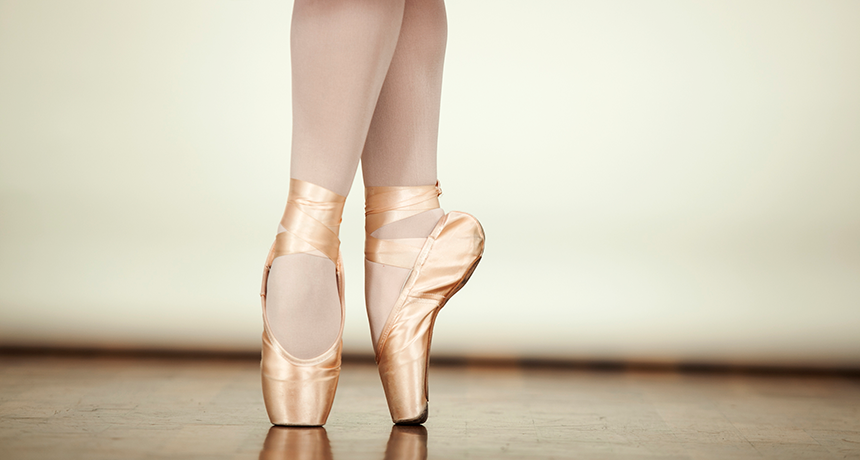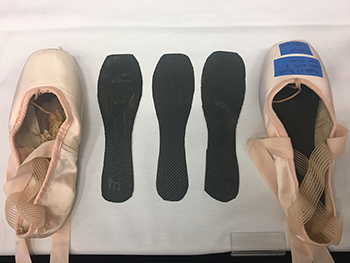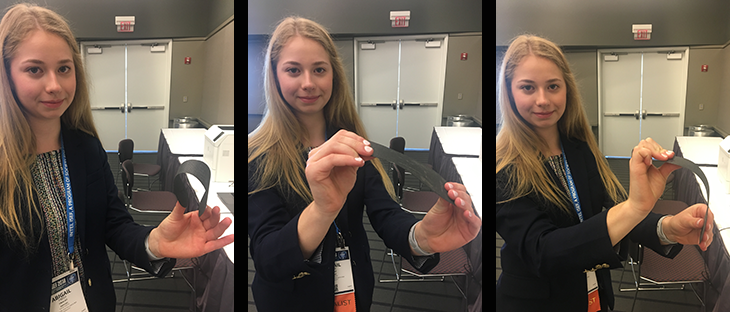Science may help keep a ballerina on her toes
A ballerina applied some science to her ballet shoes to make them last longer

These are a ballerina’s pointe shoes. A dancer will go through many pairs, but one teen used a science fair project to figure out how to save money — and a lot of shoes.
mavkate/iStockphoto
PITTSBURGH, Pa. — Ballet dancers can go through a lot of toe shoes — the ones they need to stand en pointe, meaning on the tips of their toes. “I go through about a pair a performance,” says Abigail Freed, 17. The South Carolina ballerina is a junior at Hilton Head Prep School on Hilton Head Island. “We did six shows and I went through six pairs,” she recalls. The reason? The shoes’ shank — that rigid piece of material that strengthens the bottom of the shoe — kept breaking. Her frustration inspired this teen to use science to develop a longer-lasting shank.
Ballerinas are tough on their shoes. That’s because ballet is tough on their toes.
When a ballerina looks like she is standing on the tips of her toes, that’s because she is. What makes this possible is her footwear. Pointe shoes have two pivotal parts. A “box” holds the toes in place. It never bends. A firm shank also runs along the bottom of the entire foot to support some of a dancer’s weight. This part has to bend. In fact, when a ballerina is up on her toes, her shoe “is bending [the shank] back almost 90 degrees,” Abigail notes. (That’s a bend almost equal to the corner on a square.)

Both of these shoe parts help support a dancer as she glides lightly across the floor. But the weak part is the shank. It isn’t built to stand up to the repeated stress of bending under a dancer’s weight as she hops, leaps and then hops some more, Abigail explains.
Her science fair project relied on only one pair of ballet shoes — and one dancer. Still, her innovative shank shows promise, the teen says. She’s used them in one pair of shoes. “They are the [only] shoes I’ve danced in since the end of December,” she points out. “And they still feel the same as they did when I first put them on.” Even by mid-May, she noted, “they’re not showing signs of giving out.”
Abigail brought her pointe shoes and their novel carbon-fiber shanks here, last month, to the Intel International Science and Engineering Fair (ISEF). Created in 1950 and still run by Society for Science & the Public, this event brought nearly 1,800 students from 81 countries together to compete for almost $5 million in prizes. (The Society also publishes Science News for Students and this blog.) This year’s ISEF competition was sponsored by Intel.
The teen is still dancing on her invention. She’s also working to patent it. This would give her legal control over her new-and-improved shoe insert. That would allow her to benefit if it were one day sold to help other dancers stay on their toes.
The breaking pointe
“The shank is usually leather and cardboard,” the teen explains. They won’t last long under a hardworking dancer. “With the materials and your foot sweating, it’s a recipe for disaster,” she says. Sometimes the shanks break in half. Other times they just get too soft to support the dancer. That puts a ballerina at risk of a sprained ankle or worse.
The problem is also expensive. “I was going through so many pairs of shoes,” she notes, at “$105 a pair,” that her dad became exasperated at the expense. With a science fair project coming due, Abigail decided it was time to enlist science to find a solution.
“I researched a bunch of materials,” she says. After considering plastics, she “settled on carbon fiber because it was lightweight and would still be able to bend and flex with my foot.”
Made of carbon, these fibers are only about 5 to 10 micrometers across — or about a tenth the width of a human hair. Incredibly light, flexible and strong, these fibers also can be woven to make a fabric.
The teen purchased a roll of carbon fiber fabric over the internet. She cut it to fit inside her ballet shoe and then cured it in the oven to harden. Afterward, she yanked the normal shank out of one ballet shoe, and taped the new carbon-fiber shank in its place.
The dancer put on the shoes and carefully rolled through on to her toes. The result? The carbon fiber fabric was nice and flexible. Too flexible, actually. “I thought it wasn’t going to be strong enough,” Abigail says. “I decided to stack [more of them] and cure those.”

The teen tested shanks between one and six layers thick. One by one, she substituted each in her shoes and then carefully went through her dance positions. Along the way, she bent her shoes as far as she could, over and over. She wanted to see where they reached a breaking point.
One layer was too soft. Six layers proved far too stiff, shoving her foot far forward. But two to three layers? Just right. “It’s like always having a nicely broken-in shoe that you never had to break in,” she explains. Since finding this solution, she’s never gone back.
Abigail’s friends want carbon-fiber shanks, too, but Abigail says she needs to do more tests first. She wants to make sure the new shanks are safe. “They haven’t snapped yet,” she says. “But we need to make sure they’re not going to snap on anyone’s feet.”







